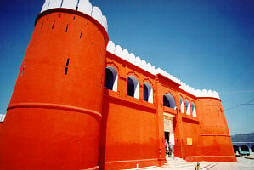Anandgarh
This Gurdwara was one of the five forts constructed by Guru Gobind Singh at Anandpur Sahib for the defense of the Sikhs. Guru Gobind Singh spent 25 years at Anandpur Sahib. To protect the Sikhs from the hill Rajas or Mughals, Guru Gobind Singh began the construction of five defensive forts all around the town. Keshgarh at the center (now a Takht), Anandgarh (fort of bliss), Lohgarh (fort of steel), Holgarh (fort of colour) and Fatehgarh (fort of victory). All the forts were joined together with earthworks and underground tunnels. The construction began in 1689 and took over ten years to complete.
Gurudwara Qila Anandgarh Sahibis situated on another spur, about 800 metres south-east of Takht Sri Kesgarh Sahib. It is a newly constructed building though marks of the old, original structure are also still traceable. The present building complex was raised during the 1970's by Sant Seva Singh (d. 1982) whose successors are now managing and further developing it.Earlier, during the 1930's, Kartar Singh Kalasvalia had got a fort-like building constructed which is still intact on top of the hillock. The present Gurdwara, separated from this building by a spacious terrace paved with slabs of streaked marble, is a 15-metre square hall with an 8x3 metre porch in front. The 6-metre square sanctum within the hall has above it a lotus dome topped with a gilded pinnacle and khanda as a fmial. The entire wall surface has a facing of streaked marble. This build-ing was completed in 1970. The water level of an old baoli, a stepped well 4-metre in diametre, is approached through a covered passage. The baoh'has 135 marbled steps. At the lower levels on the eastern flank of the main building are a spacious hall for Guru ka Langar constructed in 1972, and 300 rooms for pilgrims and administrators.

